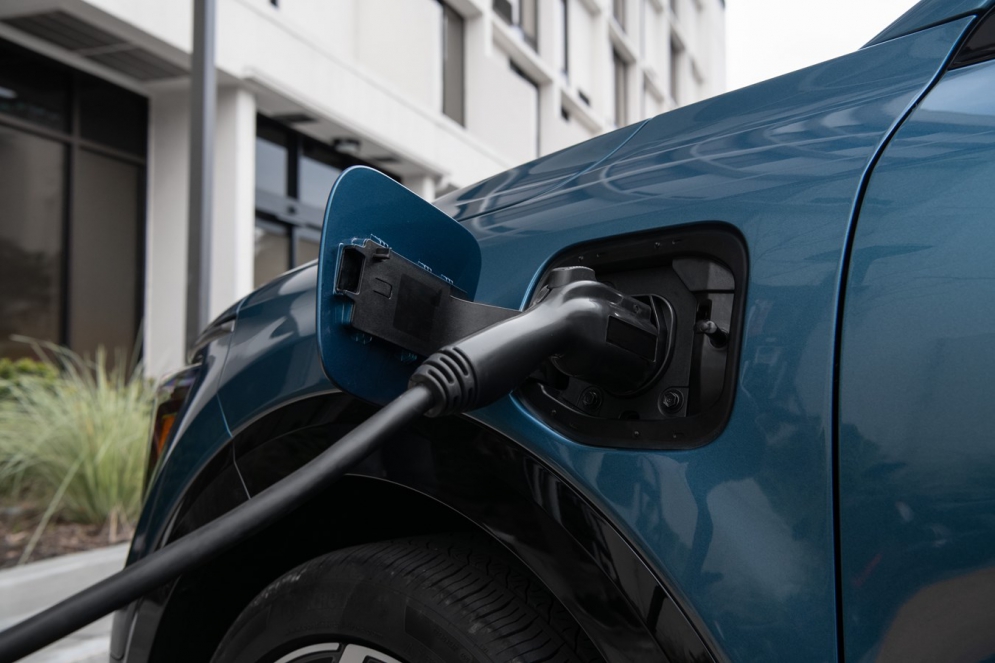LOOKS
The Niro plug-in is a fun-size compact vehicle, and not aimed at large families. It’s more of a vehicle for commuters and others who don’t need large cargo space and don't transport people daily in the back seat.
My test vehicle featured a sharp-looking Cityscape Green exterior paint color, and they also offer unique two-tone color options.
Overall, the Niro — which hasn’t seen major exterior upgrades since the 2023 model, retains a bold, appealing design compared to compact SUV rivals.
Sixteen-inch wheels are standard, but higher trims boost the wheels to 18 inches. The Niro features roof rails, rear privacy glass, LED lighting, rain-sensing wipers, a power Sunroof, and power-folding outside mirrors.
Moving inside the vehicle, you’ll find what you should expect from a compact ride. The front seats are comfortable, but the back seat is a bit tight due to the compact size.
WIth leg room limited in the back row, I recommend it mostly for kids or small adults, but you get a solid amount of headroom in both rows.
The Niro does not offer a luxurious interior, but it’s still a decent quality. The cloth and SynTex seating is comfortable, but a bit firm.
The center console features a rotary dial for shifting, and well-placed buttons for heated seats and heated steering wheel. The tech setup and dashboard look sleek and modern.
Heated and ventilated front seats are offered, and the Niro comes with dual-zone automatic climate control with rear vents, LED interior lighting and aluminum pedals.
The Niro is not a vehicle meant for large cargo — offering 19 cubic feet with rear seats up, and 55 cubic feet with those seats folded down. These numbers are competitive among rival compact SUV plug-in hybrids.
HOW’S THE RIDE?
The Kia Niro plug-in is powered by a 1.6-liter, four-cylinder plug-in hybrid engine — paired with a 62-kW electric motor and 11.1-kwH lithium-ion battery pack.
It uses a 6-speed automatic transmission, and delivers numbers of 180 horsepower and 195 pound-feet of torque, and delivers 33 miles of all-electric range.
The vehicle is offered with front-wheel drive only, and uses a rotary gear selector.
If you opt for the standard hybrid, without plug-in capability, you will drop to 139 horsepower, but keep the 195 pound-feet of torque.
The Niro plug-in offers a ride quality that’s not overly exciting but still respectable. It’s a smooth ride, and more powerful and perky than the numbers would indicate. I never felt sluggish in the performance.
The Niro is compact, agile, easy to maneuver, and responsive to driver input. Lack of AWD is the only disappointing aspect.
You’ll be able to get from 0-to-60 miles per hour in the mid 7-second range with the Niro plug-in, compared to roughly 9 seconds with the standard hybrid and its lower horsepower. The only way to go faster than the plug-in in a Niro is to opt for the full-EV offering, which is more expensive.
There are two drive modes offered on the Niro plug-in: Eco and Sport.
And due to its size, the Niro is not rated for towing. But there is the option of storing some materials on its roof.
TECHNOLOGY, SAFETY
The Kia Niro PHEV features a large, 10.25-inch rectangular touchscreen that works well and is user-friendly, and voice commands also worked great in the vehicle.
Another strip of controls is below, also touchscreen, and features a unique setup where it rotates between tech and climate controls. I found this to be overly convoluted to control, especially while driving. It’s a setup that is innovative in theory (it saves space by combining features into one area), but cumbersome in real life use.
Other tech features in the Niro include Android Auto & Apple CarPlay connectivity for phone mirroring, Kia Connect with a free 12-month trial, three free months of satellite radio (worth the subscription to keep it going), remote start, a wireless Phone Charger, plus USB and 12-volt outlets.
A Harman Kardon sound system sounds loud and clear, with both bass and treble delivered effectively, and the Niro offers Smartphone Digital Key.
On the safety side, the Niro is well-stacked, especially considering it’s a smaller vehicle than most SUVs for sale today.
The Adaptive Cruise Control and Lane Centering features combine to create a solid self-driving setup that was reliable and trustworthy. And you get plenty of warnings when vehicles are around you.
The Rear View Camera with Dynamic Guidelines was extremely helpful for parking, and a full array of airbags is included.
Other safety features include:
— Forward collision warning with automatic braking
— Intersection collision mitigation (applies brakes in turning scenarios)
— Lane departure mitigation (keeps vehicle in your lane)
— Driver attention warning (senses driver fatigue)
— Blind-Spot Collision Warning
— Lane Following Assist
— Safe Exit Warning (warns of oncoming traffic before you open the door)
— Automatic high-beam headlights
All in all, the Niro is among the safer smaller SUVs you can buy. So it’s not a surprise that it gets a 5-star NHTSA safety rating.
MPG, RANGE, CHARGING
Fuel mileage numbers are stout on the Kia Niro plug-in hybrid, coming in at 108 MPGe (combined gas and electric rating), and 48 miles per gallon when running on gasoline only.
Its electric-only range is listed at 33 miles, which is enough for people with shorter commutes to avoid using gas during most trips if they do regular home charging.
My time driving the Niro PHEV brought back lower numbers when driving on gas only, landing in the high-30s, but it was during a period of low temperatures and winter weather, which can impact fuel mileage (Something to consider if you live in those types of environments).
The electric-only range is behind some rival plug-ins (i.e. the RAV4 Prime), but on par with several other rivals.
If you have a Level 2 charger at your home, and can charge it most evenings to keep it topped off, you should find yourself making rare trips to the gas station unless you are going on long drives in addition to your commute. Charging the vehicle should take you less than three hours.
If you really want to max out miles per gallon and aren’t committed to the plug-in version, a standard hybrid version of the Niro is listed at 53 miles per gallon.
A standard, non-hybrid version of the Niro offers 49 mpg. And on the opposite end, a full EV version comes in at 113 MPGe (126 city/101 highway).
PRICE
The Niro plug-in hybrid comes in a couple trim levels, The base EX trim will cost you about $35K, while the SX Touring trim will cost you around $42K.
In the grand scheme of plug-in hybrids available in today’s marketplace, a vehicle starting at $35k is a rare find, and among the least you’ll spend for the ability to plug in. This makes sense, though, because the Niro is smaller than most other plug-in SUV offerings.
The regular hybrid, without plug-in capability, comes in multiple trim levels (LX, EX, EX Touring, SX, SX Touring) with starting prices ranging from $28K to $36K.
The test of whether to opt for the plug-in versions over the hybrid or gas versions of the Niro is whether your driving patterns will allow for maximizing the electric miles, which will save you trips to the gas station. And those who want the plug-in, but are on a budget will want to stick to the EX trim and not make the leap to the SX Touring version.
Helping with the value proposition is the Niro PHEV offers Kia’s industry-leading warranties.
These include
— 10 Year/100,000 Mile Limited Powertrain Warranty
— 10 Year/100,000 Mile Limited Battery Warranty
— 5 Year/60,000 Mile Limited Basic Warranty
— 5 Year/60,000 Mile Roadside Assistance
The only thing missing is complimentary scheduled maintenance.
BOTTOM LINE
The Kia Niro plug-in hybrid is a solid choice for compact SUV buyers seeking a vehicle with strong fuel economy and plug-in capability, and a lower price tag than most plug-in hybrids.
It’s one of many vehicle options in the Niro family, and city dwellers are a key target due to its compact size. If you fit this category and aren’t willing to go fully electric yet, the Niro PHEV might be your best bet.
===
AutoTechReviews.com can be found on Twitter @AutoTechReview, or stay updated at the AutoTechReviews Facebook page. Follow AutoTechReviews on Instagram at @Autotechreviews or on TikTok at @AutoTechReviews.. Matt Myftiu can be found on Twitter @MattMyftiu.




